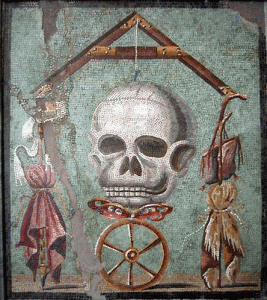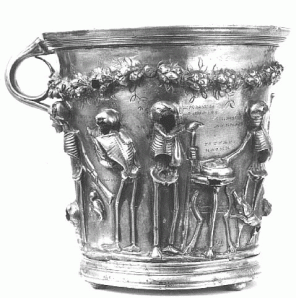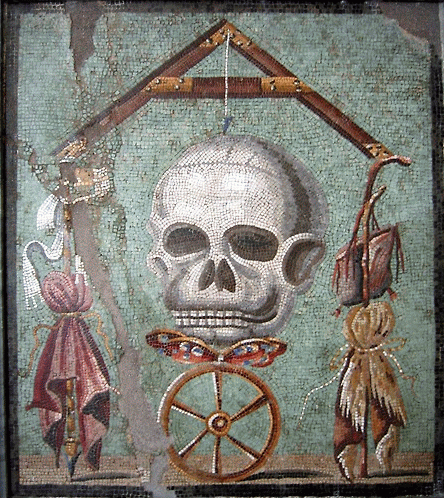Epicurean Art in the Ancient World
This post is to announce a new page devoted to collecting images of art from the ancient world which appear to have Epicurean themes. Please email suggestions for inclusion in this list. (Note: A number of comments are posted below, and I will expand this list over time. Rather than make those changes here, however, they will be made on the main Epicurean Art Page. Please see that page, rather than this blog entry, for the latest version of this material. In regard to the Pompeiian mosaic, see this page for a much-expanded discussion.
 |
MEDITATE MORTEM: Meditate on death.**The mosaic to the left is identified by the National Archaelogical Museum of Naples as being found in Pompeii in the “House cum workshop, I, 5, 2, triclinium,” and is estimated as dating from between 30 BC to 14 AD. The museum inscription reads in part: “This emblem was displayed in a triclinium and is one of the most striking for the clarity of its allegorical representation. … The composition is surmounted by a level with a plumb line, the instrument used by masons to get their constructions straight and level. Below are … death (the skull) below which are a butterfly (the soul) and a wheel (fortune). On each side, suspended from the arms of the level and kept in perfect balance … are the symbols of wealth and power on the left (the sceptre and purple) and poverty on the right (the beggar’s scrip and stick). The theme, like the skeletons on the silverware in the treasure of Boscoreale, was intended to remind diners of the fleeting nature of earthly fortunes.”Among the following passages that this image might have evoked in the minds of those familiar with Lucretius are the following:
** from Seneca’s Letter XXVI to Lucilius: “Think on death. … The meaning is clear – that it is a wonderful thing to learn thoroughly how to die. You may deem it superfluous to learn a text that can be used only once; but that is just the reason why we ought to think on a thing. When we can never prove whether we really know a thing, we must always be learning it. “Think on death.” In saying this, he bids us think on freedom. He who has learned to die has unlearned slavery; he is above any external power, or, at any rate, he is beyond it. What terrors have prisons and bonds and bars for him? His way out is clear. There is only one chain which binds us to life, and that is the love of life. The chain may not be cast off, but it may be rubbed away, so that, when necessity shall demand, nothing may retard or hinder us from being ready to do at once that which at some time we are bound to do.” |
 |
BOSCOREALE CUP: Among the descriptions on the internet is the following:The Boscoreale treasure included this cup which reputedly has Epicurean maxims engraved along with the skeletons. A Latin inscription on the base of one of the cups gives their weight and the name of their owner, Gavia. Greek inscriptions engraved in dots form captions, and are accompanied by Epicurean maxims such as: “Enjoy life while you can, for tomorrow is uncertain.” Clotho, one of the Fates, looks on as Menander, Euripides, Archilochus, Monimus the Cynic, Demetrius of Phalera, Sophocles, and Moschion provide a caustic and ironic illustration of the fragility and vanity of the human condition. But the main message of the cups’ decoration is that life should be enjoyed to the full: Zeno and Epicurus, the founders of the Stoic and Epicurean philosophies in the 4th century BC, confront each other before two mating dogs—a detail of some significance, as it represents the triumph of Epicureanism.
|

